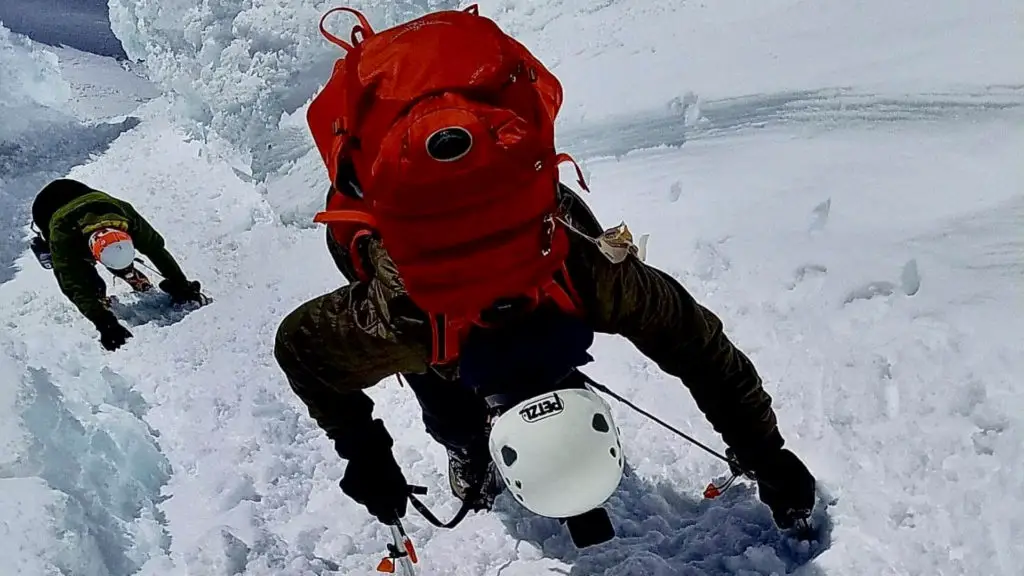When it comes to backpacks, a day pack is my go-to when my UL pack or hydration vest just isn’t quite enough, and my overnight backpack is too much. A good day pack will typically have a 2 liter hydration reservoir and will always have plenty of nooks and crannies to organize snacks, first aid kit, batteries/charger, layers, jackets, headlamp, microspikes, bathingsuit, who knows, plus loops and straps for trekking poles or an ice axe, and a couple small pockets on the hipbelt for easy access.
The size of your typical day pack will range from about 10 to 30 liters. This wide range includes everything from tiny bare-bones packs for short trail runs to bigger packs for inclement weather adventures that require more layers and more gear, or for parents who carry extra food and clothing for their kids.
Note as you’re pack shopping that the capacity is usually a part of the name of the pack, like my Osprey Skimmer 33, which makes it easier when shopping to not have to look up specs of each to know the size.
[amazon box=”B07JMGN13C” template=”horizontal”]
Types of Frames
Frameless: Frameless packs are great for lighter loads as they weigh very little. But their lightweight and compact structure lacks the support of a pack with a frame. These are great if you find yourself doing more trail running or roped climbing than hiking. My Black Diamond Speed Zip 24 is a climber’s pack that I love for short hikes because it weighs next to nothing and has a slim profile for wiggling between tight places during scrambling or bushwhacking.
[amazon box=”B011K8Q7AM” template=”horizontal”]
Internal frame: Gone are the days of the external aluminum frame. Most daypacks have an internal frame that helps support the weight you’re carrying or a plastic framesheet that adds lightweight structure. The more substantial the frame, the more weight the pack can handle, but also the more it itself weighs, so if you’re looking to shave ounces off your load, go frameless. If weight isn’t a huge concern and you like the structure or fit of an internal frame, they do help distribute the weight of your load for a smooth carry.
Pack Access
Top: The majority of daypacks are top-loading, and you can simply pack things you won’t need much if at all (emergency layers, extra food) on the bottom, and pile things on top (gloves, food) that you want easy access to, and save the smaller pockets for smaller items like first aid kit, headlamp, phone charger, snacks.
Front or bottom: Packs with front panel access offer access to the main storage compartment via a U-shaped zipper which enables you to get to those bottom-of-the-pack items without having to pull everything on top out. Some packs offer a bottom zipper to accomplish the same thing. Both of these are great for cold weather hikes during which your moving body temp, resting body temp, and the weather all fluctuate with such frequency that having to rely on only top access would become quite time consuming.
Side: A side zip to the main storage compartment is an option on some daypacks. This is typically in addition to top access and is just one more way to access deep-pack items without unpacking.
Hydration Reservoir
Most daypacks have an inside pocket that you can slip a hydration reservoir into. Depending on the make and model you decide on, the reservoir (also called a bladder) will either come with the pack or you’ll need to buy one separately. Average size of reservoirs ranges from 1.5 to 3 liters and having such easy access to water helps ensure you’ll stay well hydrated throughout any hike.
Other Features
Suspended mesh panel: Some packs have a ventilated/mesh back panel that’s constructed so the pack sits a few inches away from your back, allowing a steady flow of air to help alleviate the sweat-soaked back that comes from having your pack right against your body for long periods of time. Look for this if you sweat a lot or are going to be hiking in cooler temps a lot; soaking a shirt with sweat then sitting for long breaks or summits is a recipe for a bad case of the chills.
Raincover: If you are going somewhere super rainy, a raincover is a good idea, though most packs are to some degree water resistant. Some packs include them, for others it’s a separate purchase.
Sleeping bag compartment: A few of the bigger daypacks have a compartment at the bottom of the pack for light, compressible gear like puffy jackets, or even sleeping bags if you’re an ultralight backpacker who uses a day pack on your overnights.
My top ten favorite makes and models especially designed for the female frame:
- Gregory Jade 28
- Gregory Maya 22
- Deuter Speed Lite 20
- Osprey Tempest 20
- Osprey Sirrus 24
- Osprey Kyte 36
- Patagonia Nine Trails
- Deuter Trail 28
- Camelback Fourteener 21

Wendy Harrington is a California native who has lived in a small town at the foothills of the Cascade Mountains in Washington state since 2001. Her love of trail running and peakbagging has led her to summit all five Washington volcanoes, climb to the high points of three states, and put nearly a thousand miles a year on her boots. Her loves include ridgelines, saddles, granite, one-day pushes on big mountains, anything volcanic, long solo days, and objectives that push limits and test endurance.

